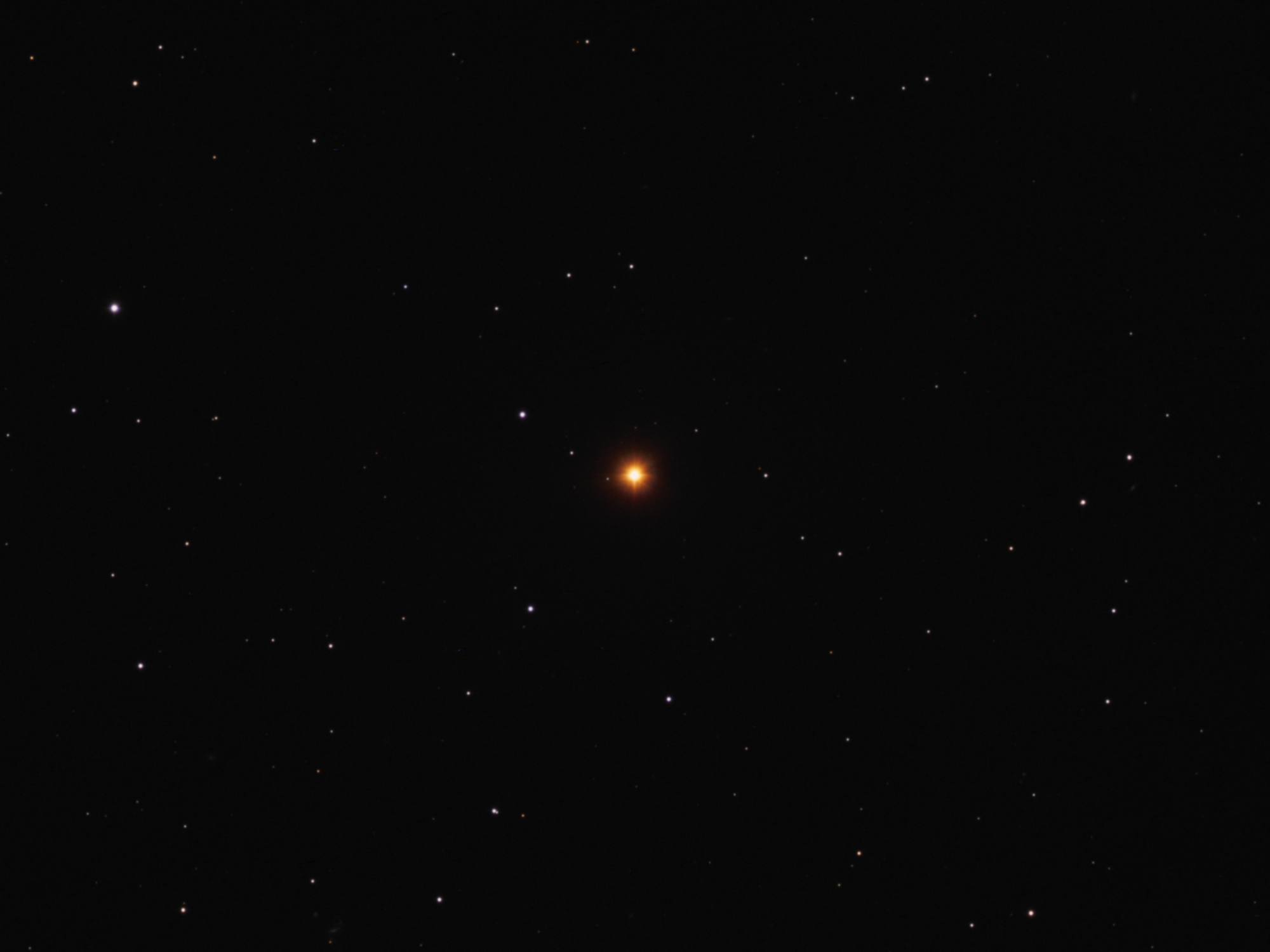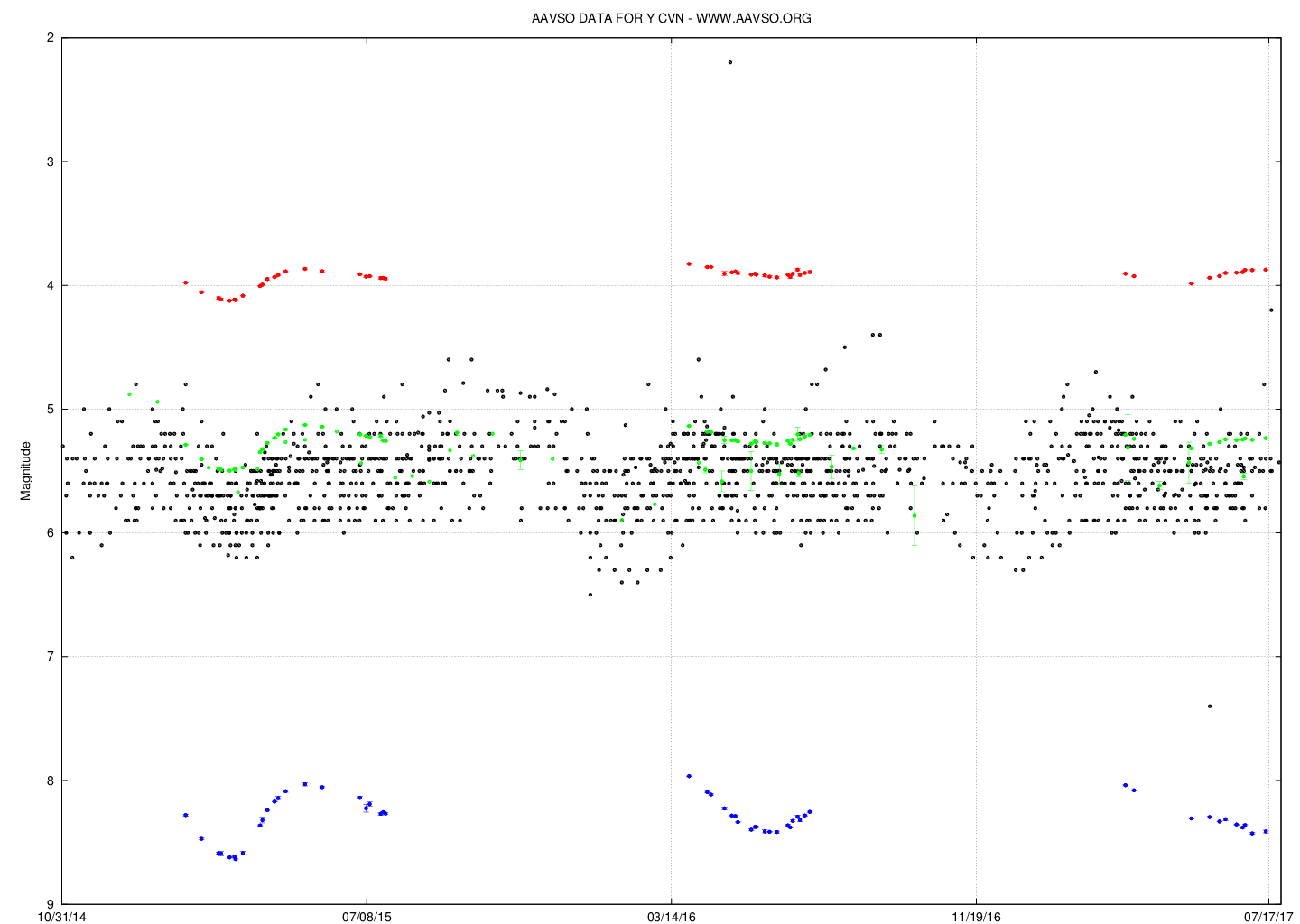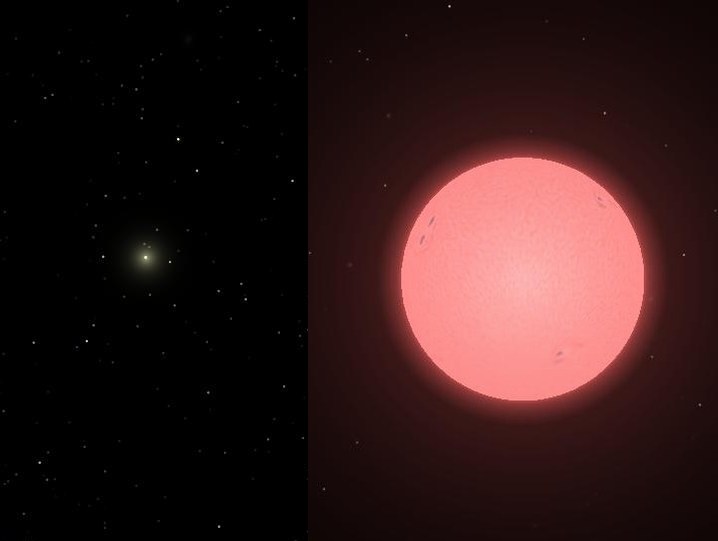Y Canum Venaticorum on:
[Wikipedia]
[Google]
[Amazon]
La Superba (Y CVn, Y Canum Venaticorum) is a strikingly red giant star in the
 La Superba is a
La Superba is a
 The angular diameter of La Superba has been measured at . It is expected to be pulsating but this has not been seen in the measurements. At , this corresponds to a radius of . If it were placed at the position of the Sun, the star's surface would extend beyond the
The angular diameter of La Superba has been measured at . It is expected to be pulsating but this has not been seen in the measurements. At , this corresponds to a radius of . If it were placed at the position of the Sun, the star's surface would extend beyond the
 After stars up to a few times the mass of the sun have finished fusing
After stars up to a few times the mass of the sun have finished fusing
constellation
A constellation is an area on the celestial sphere in which a group of visible stars forms Asterism (astronomy), a perceived pattern or outline, typically representing an animal, mythological subject, or inanimate object.
The origins of the e ...
Canes Venatici. It is a carbon star
A carbon star (C-type star) is typically an asymptotic giant branch star, a luminous red giant, whose atmosphere contains more carbon than oxygen. The two elements combine in the upper layers of the star, forming carbon monoxide, which consumes mos ...
and semiregular variable.
Visibility
 La Superba is a
La Superba is a semiregular variable star
In astronomy, a semiregular variable star, a type of variable star, is a giant or supergiant of intermediate and late (cooler) spectral type showing considerable periodicity in its light changes, accompanied or sometimes interrupted by various irre ...
, varying by about a magnitude over a roughly 160-day cycle, but with slower variation over a larger range. Periods of 194 and 186 days have been suggested, with a resonance between the periods.
Y CVn is one of the reddest star
A star is an astronomical object comprising a luminous spheroid of plasma (physics), plasma held together by its gravity. The List of nearest stars and brown dwarfs, nearest star to Earth is the Sun. Many other stars are visible to the naked ...
s known, and it is among the brightest of the giant red carbon star
A carbon star (C-type star) is typically an asymptotic giant branch star, a luminous red giant, whose atmosphere contains more carbon than oxygen. The two elements combine in the upper layers of the star, forming carbon monoxide, which consumes mos ...
s. It is the brightest of known J-star
J-Star stands for Jungiery Star. Jungiery is a Taiwanese Artiste Management Company.
Members of J-Star are: 5566, 183 Club, 7 Flowers, Typhoon, Taiji, LALA, VJ and Cyndi Wang. R&B and K-One used to be part of J-Star too. Some of the original R& ...
s, which are a very rare category of carbon stars that contain large amounts of carbon-13 (carbon atoms with 7 neutron
The neutron is a subatomic particle, symbol or , which has a neutral (not positive or negative) charge, and a mass slightly greater than that of a proton. Protons and neutrons constitute the nuclei of atoms. Since protons and neutrons beh ...
s instead of the usual 6). The 19th century astronomer
An astronomer is a scientist in the field of astronomy who focuses their studies on a specific question or field outside the scope of Earth. They observe astronomical objects such as stars, planets, natural satellite, moons, comets and galaxy, g ...
Angelo Secchi, impressed with its beauty, gave the star its common name, which is now accepted by the International Astronomical Union
The International Astronomical Union (IAU; french: link=yes, Union astronomique internationale, UAI) is a nongovernmental organisation with the objective of advancing astronomy in all aspects, including promoting astronomical research, outreac ...
.
Properties
 The angular diameter of La Superba has been measured at . It is expected to be pulsating but this has not been seen in the measurements. At , this corresponds to a radius of . If it were placed at the position of the Sun, the star's surface would extend beyond the
The angular diameter of La Superba has been measured at . It is expected to be pulsating but this has not been seen in the measurements. At , this corresponds to a radius of . If it were placed at the position of the Sun, the star's surface would extend beyond the orbit
In celestial mechanics, an orbit is the curved trajectory of an object such as the trajectory of a planet around a star, or of a natural satellite around a planet, or of an artificial satellite around an object or position in space such as a p ...
of Mars
Mars is the fourth planet from the Sun and the second-smallest planet in the Solar System, only being larger than Mercury (planet), Mercury. In the English language, Mars is named for the Mars (mythology), Roman god of war. Mars is a terr ...
.
La Superba's temperature
Temperature is a physical quantity that expresses quantitatively the perceptions of hotness and coldness. Temperature is measured with a thermometer.
Thermometers are calibrated in various temperature scales that historically have relied o ...
is believed to be about , making it one of the coolest
Coolness is an aesthetic of attitude, behavior, comportment, appearance, and style that is generally admired. Because of the varied and changing interpretation of what is considered "cool," as well as its subjective nature, the word has no sing ...
true stars known. It is faintly visible to the naked eye, and the red colour is very obvious in binoculars. When infrared
Infrared (IR), sometimes called infrared light, is electromagnetic radiation (EMR) with wavelengths longer than those of visible light. It is therefore invisible to the human eye. IR is generally understood to encompass wavelengths from around ...
radiation is included, Y CVn has a bolometric luminosity several thousand times that of the Sun. The mass of this type of star is difficult to determine; it would initially have been around and somewhat less now due to mass loss. An estimate from Jim Kaler gives the star a luminosity between and radius between based on an assumed temperature of 3,000 K, and the author then classified it as a C7 or CN5 supergiant star although its mass is too low to be a true supergiant.
Observations in the 60 and 100 micron infrared bands by the IRAS
The Infrared Astronomical Satellite (Dutch: ''Infrarood Astronomische Satelliet'') (IRAS) was the first space telescope to perform a survey of the entire night sky at infrared wavelengths. Launched on 25 January 1983, its mission lasted ten mo ...
satellite showed that Y CVn is surrounded by a dust shell 0.9 parsecs in diameter.
This is one of the most prominent circumstellar dust shells detected in the IRAS all-sky survey.
Evolution
 After stars up to a few times the mass of the sun have finished fusing
After stars up to a few times the mass of the sun have finished fusing hydrogen
Hydrogen is the chemical element with the symbol H and atomic number 1. Hydrogen is the lightest element. At standard conditions hydrogen is a gas of diatomic molecules having the formula . It is colorless, odorless, tasteless, non-toxic, an ...
to helium
Helium (from el, ἥλιος, helios, lit=sun) is a chemical element with the symbol He and atomic number 2. It is a colorless, odorless, tasteless, non-toxic, inert, monatomic gas and the first in the noble gas group in the periodic table. ...
in their core, they start to burn hydrogen in a shell outside a degenerate helium
Helium (from el, ἥλιος, helios, lit=sun) is a chemical element with the symbol He and atomic number 2. It is a colorless, odorless, tasteless, non-toxic, inert, monatomic gas and the first in the noble gas group in the periodic table. ...
core, and expand dramatically into the red giant
A red giant is a luminous giant star of low or intermediate mass (roughly 0.3–8 solar masses ()) in a late phase of stellar evolution. The outer atmosphere is inflated and tenuous, making the radius large and the surface temperature around or ...
state. Once the core reaches a high enough temperature, it ignites violently in the helium flash
A helium flash is a very brief thermal runaway nuclear fusion of large quantities of helium into carbon through the triple-alpha process in the core of low mass stars (between 0.8 solar masses () and 2.0 ) during their red giant phase (the Sun is ...
, which begins helium core burning on the horizontal branch
The horizontal branch (HB) is a stage of stellar evolution that immediately follows the red-giant branch in stars whose masses are similar to the Sun's. Horizontal-branch stars are powered by helium fusion in the core (via the triple-alpha process) ...
. Once even the core helium is exhausted, a degenerate carbon-oxygen core remains. Fusion continues in both hydrogen and helium shells at different depths in the star, and the star increases luminosity on the asymptotic giant branch
The asymptotic giant branch (AGB) is a region of the Hertzsprung–Russell diagram populated by evolved cool luminous stars. This is a period of stellar evolution undertaken by all low- to intermediate-mass stars (about 0.5 to 8 solar masses) lat ...
(AGB). La Superba is currently an AGB star.
In the AGB stars, fusion products are moved outwards from the core by strong deep convection
Convection is single or multiphase fluid flow that occurs spontaneously due to the combined effects of material property heterogeneity and body forces on a fluid, most commonly density and gravity (see buoyancy). When the cause of the convec ...
known as a dredge-up A dredge-up is any one of several stages in the evolution of some stars. By definition, during a ''dredge-up'', a convection zone extends all the way from the star's surface down to the layers of material that have undergone fusion. Consequently, th ...
, thus creating a carbon
Carbon () is a chemical element with the symbol C and atomic number 6. It is nonmetallic and tetravalent
In chemistry, the valence (US spelling) or valency (British spelling) of an element is the measure of its combining capacity with o ...
abundance in the outer atmosphere where carbon monoxide
Carbon monoxide (chemical formula CO) is a colorless, poisonous, odorless, tasteless, flammable gas that is slightly less dense than air. Carbon monoxide consists of one carbon atom and one oxygen atom connected by a triple bond. It is the simple ...
and other compounds are formed. These molecule
A molecule is a group of two or more atoms held together by attractive forces known as chemical bonds; depending on context, the term may or may not include ions which satisfy this criterion. In quantum physics, organic chemistry, and bioch ...
s tend to absorb radiation at shorter wavelengths, resulting in a spectrum
A spectrum (plural ''spectra'' or ''spectrums'') is a condition that is not limited to a specific set of values but can vary, without gaps, across a continuum. The word was first used scientifically in optics to describe the rainbow of colors i ...
with even less blue and violet compared to ordinary red giants, giving the star its distinguished red color.
La Superba is most likely in the final stages of fusing its remaining secondary fuel (helium) into carbon and shedding its mass at the rate of about a million times that of the Sun's solar wind. It is also surrounded by a 2.5 light year
A light-year, alternatively spelled light year, is a large unit of length used to express astronomical distances and is equivalent to about 9.46 trillion kilometers (), or 5.88 trillion miles ().One trillion here is taken to be 1012 ...
-wide shell of previously ejected material, implying that at one point it must have been losing mass as much as 50 times faster than it is now. La Superba thus appears almost ready to eject its outer layers to form a planetary nebula, leaving behind its core in the form of a white dwarf
A white dwarf is a stellar core remnant composed mostly of electron-degenerate matter. A white dwarf is very dense: its mass is comparable to the Sun's, while its volume is comparable to the Earth's. A white dwarf's faint luminosity comes fro ...
.
Notes
References
External links
* https://web.archive.org/web/20051025230148/http://www.nckas.org/carbonstars/ * http://www.backyard-astro.com/deepsky/top100/11.html * http://jumk.de/astronomie/big-stars/la-superba.shtml {{DEFAULTSORT:La Superba Semiregular variable stars Canes Venatici Carbon stars Stars with proper names Canum Venaticorum, Y 110914 4846 062223 Durchmusterung objects Asymptotic-giant-branch stars